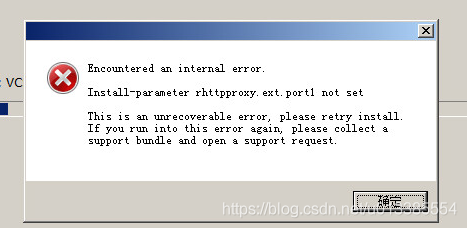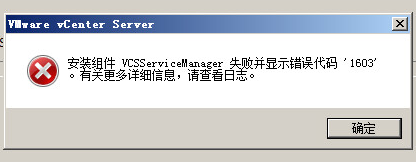background
VCeter Server was deployed in a virtual machine of Windows Server 2008 R2. Due to the change of virtual machine network card configuration, vCenter Server related services could not be started. After searching for a solution, I planned to reinstall vCenter Server.
Problems encountered
The deployment process blog.csdn.net/shengxia1999/article/details/52353177 mainly refer to this article. Here I mainly explain the problems I have encountered and the solutions. When Encountered with an internal error during the installation process, the specific error message of install-parameter Rhttpproxy. Ext.port1 not Set is shown in the figure below:

After this error occurs, the installation will exit, and at the end, ‘Installation component VCSServiceManager failed and error code 1603’ will be reported, as shown below:

If this error occurs, you should first check to see if the HTTP port configured during vCenter Server installation is occupied (using the command netstat -nao). If the port is not occupied, use the following method:
1. Delete C:\Program Files\VMware\vCenter Server directory;
2. Restart the virtual machine and reinstall
conclusion
This method may not solve all of these problems, but this is just one solution.
VCeter Server was deployed in a virtual machine of Windows Server 2008 R2. Due to the change of virtual machine network card configuration, vCenter Server related services could not be started. After searching for a solution, I planned to reinstall vCenter Server.
Problems encountered
The deployment process blog.csdn.net/shengxia1999/article/details/52353177 mainly refer to this article. Here I mainly explain the problems I have encountered and the solutions. When Encountered with an internal error during the installation process, the specific error message of install-parameter Rhttpproxy. Ext.port1 not Set is shown in the figure below:

After this error occurs, the installation will exit, and at the end, ‘Installation component VCSServiceManager failed and error code 1603’ will be reported, as shown below:

If this error occurs, you should first check to see if the HTTP port configured during vCenter Server installation is occupied (using the command netstat -nao). If the port is not occupied, use the following method:
1. Delete C:\Program Files\VMware\vCenter Server directory;
2. Restart the virtual machine and reinstall
conclusion
This method may not solve all of these problems, but this is just one solution.